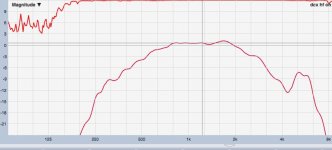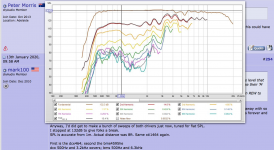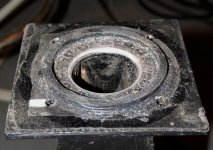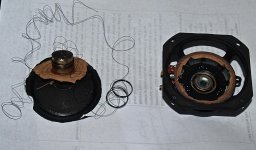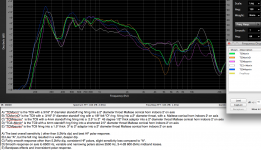I guess you want to blow away empty cans at home !
Regards
Charles
Well heck yeah!!
Disclaimer: I've never designed and built speakers, I've only built kits so far.
In doing some research, I found this:
"If a first-order, lowpass filter is used in the crossover, and 1-dB flatness is desired, the woofer response should be within about 2 dB of flat up to at least twice the crossover frequency. For a second-order crossover, the woofer response should be within 2 dB of flat up to a half-octave (roughly 40%) above the crossover frequency. For a third-order crossover, that level of flatness should extend to at least one-third octave (roughly 26%) above the crossover frequency."
I felt like the B&C 18SW115-4 was looking pretty good. Then I noticed that you were using the BMS 18N862 so I looked up a frequency response graph and then modeled it with WinISD...that thing looks like it'd be phenomenal in this application! And, depending on if someone wants to run one or two per waveguide, it's available in 4 ohm and 8 ohm.
So I have two more questions if you don't mind...
I may have missed it but, have you tried it with a woofer above and one below the waveguide?
Where does one find the BMS woofers?
In doing some research, I found this:
"If a first-order, lowpass filter is used in the crossover, and 1-dB flatness is desired, the woofer response should be within about 2 dB of flat up to at least twice the crossover frequency. For a second-order crossover, the woofer response should be within 2 dB of flat up to a half-octave (roughly 40%) above the crossover frequency. For a third-order crossover, that level of flatness should extend to at least one-third octave (roughly 26%) above the crossover frequency."
I felt like the B&C 18SW115-4 was looking pretty good. Then I noticed that you were using the BMS 18N862 so I looked up a frequency response graph and then modeled it with WinISD...that thing looks like it'd be phenomenal in this application! And, depending on if someone wants to run one or two per waveguide, it's available in 4 ohm and 8 ohm.
So I have two more questions if you don't mind...
I may have missed it but, have you tried it with a woofer above and one below the waveguide?
Where does one find the BMS woofers?
Hi BlkSC,
I have not tried anything above the waveguide so far....the me464/dcx464 combo just sit on a single 18" box, with the CD end held up by a gallon of Duratex paint !
The research you found seems to be about using a passive low pass without any plans for EQing frequency response within the sub's passband. Personally, that doesn't make sense to me and I wouldn't chose one driver over the other due to response flatness.
I chose the 18n862 because it was my first DIY design attempt, and Josh Ricci (Data-Bass) had used the driver in both sealed and vented designs. So i had some measurements to compare my builds to. (Had same disclaimer then as you do now )
)
Vented Data-Bass: Subwoofer Measurements
Sealed Data-Bass: Subwoofer Measurements
I have been super happy with this driver, but if i were building any sub with substantial horn loading, i'd probably been more inclined to try the 18SW115-4, given it's reputation for robustness when loaded.
Anyway, what i'm trying to say is, either driver would be great.
Assistance Audio is the US BMS supplier; Lean Business, UK; TLHP. Europe.
No doubt others too....Pricing can vary widely....
I have not tried anything above the waveguide so far....the me464/dcx464 combo just sit on a single 18" box, with the CD end held up by a gallon of Duratex paint !
The research you found seems to be about using a passive low pass without any plans for EQing frequency response within the sub's passband. Personally, that doesn't make sense to me and I wouldn't chose one driver over the other due to response flatness.
I chose the 18n862 because it was my first DIY design attempt, and Josh Ricci (Data-Bass) had used the driver in both sealed and vented designs. So i had some measurements to compare my builds to. (Had same disclaimer then as you do now
Vented Data-Bass: Subwoofer Measurements
Sealed Data-Bass: Subwoofer Measurements
I have been super happy with this driver, but if i were building any sub with substantial horn loading, i'd probably been more inclined to try the 18SW115-4, given it's reputation for robustness when loaded.
Anyway, what i'm trying to say is, either driver would be great.
Assistance Audio is the US BMS supplier; Lean Business, UK; TLHP. Europe.
No doubt others too....Pricing can vary widely....
Mark,Here's the lower CD section raw, to help you judge whether you think it might work....
I think the previous raw response of the DCX464 on the ME464 with less smoothing is more telling. The response is within +/- 1.5 dB down to 315Hz, then degrades rapidly below.
Excursion should roughly double per halving of frequency down to the horn cutoff around 300Hz, but since the ME464 is (more than) -6dB at 250Hz compared to 500Hz, equalized flat, the excursion would be at least four times at 250Hz than 500 Hz. Considering Xlim is probably under 1mm for the DCX464, I'd expect it to sound "distressed" at relatively low levels below 300Hz.
I'm curious as to what the distortion looks like down low at various levels, and whether the DCX464 annular diaphragm suspension self-limits excursion down low, or the diaphragm hammers the phase plug as is typical of most dome shaped diaphragms.
I recall the upper section of the DCX464 was running into what looks like displacement distortion when crossed low, but don't recall seeing distortion measurements for the low end on the ME464, have you done them?
Art
Attachments
I agree Art, the raw unsmoothed doesn't look at all usable to me below 300Hz....not really sure why i posted 1/6th smoothed.
I guess cause i never know what folks mean by indoor use.
To me indoor = outdoor, but i think others feel if stuff is running at low levels different rules apply.
I haven't tested either section for distortion yet. I keep hearing 'seven cities of gold' and wonder why bother
I guess cause i never know what folks mean by indoor use.
To me indoor = outdoor, but i think others feel if stuff is running at low levels different rules apply.
I haven't tested either section for distortion yet. I keep hearing 'seven cities of gold' and wonder why bother
mark100, I understand what the 'seven cities of gold' refer to but I feel like I need to ask to be certain I understand it in this circumstance. Are you saying they sound so good that there is little reason to test distortion? That as long as they sound good to you, how it tests really doesn't matter?
Have any of you that have the ME464/DCX464 combo also been able to experience a JBL 2384 waveguide in combination with a 2452H-SL or 2453H-SL CD?
Have any of you that have the ME464/DCX464 combo also been able to experience a JBL 2384 waveguide in combination with a 2452H-SL or 2453H-SL CD?
Tested a pair of NSW6021's again today.
I don't know if it's the 30hrs of high power pink noise I ran through them or something else, but they sound great. Now they've met my expectations.
I would still like a bit more headroom($$$) but one PLD4.5 bridged per pair does a pretty good job.
I don't know if it's the 30hrs of high power pink noise I ran through them or something else, but they sound great. Now they've met my expectations.
I would still like a bit more headroom($$$) but one PLD4.5 bridged per pair does a pretty good job.
mark100, I understand what the 'seven cities of gold' refer to but I feel like I need to ask to be certain I understand it in this circumstance. Are you saying they sound so good that there is little reason to test distortion? That as long as they sound good to you, how it tests really doesn't matter?
Have any of you that have the ME464/DCX464 combo also been able to experience a JBL 2384 waveguide in combination with a 2452H-SL or 2453H-SL CD?
Didn't mean to be cryptic with 'seven cities of gold'...i was referring to a great one of a kind test that Art made years ago, of compression drivers and their distortion audibility with increasing SPL.
High Frequency Compression Driver Evaluation
It's a bit to wade through, but well worth the time. Certainly made me rethink things re THD.
Sorry, no experience with the JBL
Mark,I agree Art, the raw unsmoothed doesn't look at all usable to me below 300Hz....not really sure why i posted 1/6th smoothed.
I guess cause i never know what folks mean by indoor use.
To me indoor = outdoor, but i think others feel if stuff is running at low levels different rules apply.
I haven't tested either section for distortion yet.
You did post distortion results for the DCX464 on a different horn on 1/13/20, it showed it's low frequency portion to be capable of more SPL with less THD than the upper section. Below 300Hz the DCX464/ME464 distortion would look quite different than above.
That said, THD alone is not really a great indicator of determining "bad sound". As you wrote in post #83 "I changed the top one for use as a low-mid only, 120Hz to 300Hz... it was simply cleaner sounding..no sub should be asked to pull duty above low-to-mid 100Hz"
Your listening tests with a single or dual 18" below the DCX464/ME464 crossed at 300Hz point to intermodulation distortion, (the addition of two fundamental frequencies, 30Hz+250Hz creating a third frequency at 280Hz, etc.) being the sound quality issue. The IMD issue is worse in HF compression drivers, possibly from air non-linearity at high SPL in the inherently limited excursion imposed by the diaphragm proximity to the phasing plug.
With your indoor listening evaluations you probably were not pushing the DCX464/ME464 near the level required for it to sound "bad", the IMD in the 18" sounded "worse".
In my HF compression driver evaluation, I mistook IMD for ordinary HD when reporting %, though the sound of it is quite different than HD, fairly easy to hear in the high power low frequency dual tone tests of the smaller drivers.
Years later, using a 3.5" Tymphony TC9FD-18-08 "full range" driver on the test horn, found that it had far less IMD than the best of the compression drivers tested.
A little IM goes a long way as far as sounding bad. I'm curious how the DCX464/ME464's IMD would compare to cone drivers capable of similar output driven to the same SPL presented with dual sine waves.
Art
Attachments
Last edited:
Yep, when i said i hadn't made any distortion tests on either section, i meant specifically for the me464/dcx464 combo.
I'm interested in checking out the IMD on the dcx464.
Do you have any specific pairs of fundamental frequencies you would suggest?
I went back and looked at the THD plots versus multiple SPL levels made last year on the XT1464, and it's pretty clear the upper CD section is the weaker section from the gitgo.
Also, i think i'm going to mount a TC9 onto the me464, just to see what happens
I'm interested in checking out the IMD on the dcx464.
Do you have any specific pairs of fundamental frequencies you would suggest?
I went back and looked at the THD plots versus multiple SPL levels made last year on the XT1464, and it's pretty clear the upper CD section is the weaker section from the gitgo.
Also, i think i'm going to mount a TC9 onto the me464, just to see what happens
Mark,
The TC9 on the ME464 will be an interesting comparison, probably want to use the smallest rear chamber you can fit around the magnet to keep excursion low for high power testing, a coffee cup might work. Top end will be messed up by the volume of the throat chamber and no phase plug, but you will be probably be surprised by the output if this is the first time you put one on a horn.
A piano/pipe organ tuner mucisian friend recommended using tone frequencies of an augmented 6th, a “C” and “A#”, a dissonant interval of 10 semitones. As I recall, he thought that interval would sound even more dissonant when harmonics were added, and it does.
At the time, I missed that the HF drivers also had lots of IMD, the sum and difference frequencies of the original frequencies, and at sums and differences of multiples of those frequencies. In retrospect, I think those IMD components, rather than HD are what make a HF driver crossed “too low” sound awful.
I expect IMD will become progressively “nasty” in the range around and below the ME464 Fc (horn cutoff frequency) of 300Hz.
Using a 10 semitone interval rounded to the nearest whole numbers, frequencies combinations like these would be illustrative:
175, 311
196, 349
220, 392
247, 440
262, 466
294, 523
330, 587
349, 622
392, 698
Have fun, use copy and paste to keep the test time as short as possible, don’t want any magic smoke released!
Art
The TC9 on the ME464 will be an interesting comparison, probably want to use the smallest rear chamber you can fit around the magnet to keep excursion low for high power testing, a coffee cup might work. Top end will be messed up by the volume of the throat chamber and no phase plug, but you will be probably be surprised by the output if this is the first time you put one on a horn.
A piano/pipe organ tuner mucisian friend recommended using tone frequencies of an augmented 6th, a “C” and “A#”, a dissonant interval of 10 semitones. As I recall, he thought that interval would sound even more dissonant when harmonics were added, and it does.
At the time, I missed that the HF drivers also had lots of IMD, the sum and difference frequencies of the original frequencies, and at sums and differences of multiples of those frequencies. In retrospect, I think those IMD components, rather than HD are what make a HF driver crossed “too low” sound awful.
I expect IMD will become progressively “nasty” in the range around and below the ME464 Fc (horn cutoff frequency) of 300Hz.
Using a 10 semitone interval rounded to the nearest whole numbers, frequencies combinations like these would be illustrative:
175, 311
196, 349
220, 392
247, 440
262, 466
294, 523
330, 587
349, 622
392, 698
Have fun, use copy and paste to keep the test time as short as possible, don’t want any magic smoke released!
Art
Thanks for that Art. Will try those frequencies / relationship.
What's the best way you've found to fairly easily match small cone drivers to 1.4" horns?
The bit of experimenting i did today makes me think i need a round throat adapter on one end the full diameter of the cone driver, that flares down to 1.4" on the other end, over who knows what adapter length....
The closer i headed to that idea the better things got.....but totally clueless really....
Don't laugh, but i've been testing the little baby doll TC9 with a PL380, at full +32dB....
It's just what was handy.
Maybe getting a little overconfident with controlling levels, huh? Lol ...
... can you smell the smoke already ?!
What's the best way you've found to fairly easily match small cone drivers to 1.4" horns?
The bit of experimenting i did today makes me think i need a round throat adapter on one end the full diameter of the cone driver, that flares down to 1.4" on the other end, over who knows what adapter length....
The closer i headed to that idea the better things got.....but totally clueless really....
Don't laugh, but i've been testing the little baby doll TC9 with a PL380, at full +32dB....
It's just what was handy.
Maybe getting a little overconfident with controlling levels, huh? Lol ...
... can you smell the smoke already ?!
A lot of great info in this thread for full-range on horn content.
A Bookshelf Multi-Way Point-Source Horn
The XBush Mark 2. A synergy/Unity horn of spherical proportions
Don't run too many high power sweeps on the TC9....I easily fried a more sensitive Lavoce 4".
At least the TC's cost less than a decent dinner!
A Bookshelf Multi-Way Point-Source Horn
The XBush Mark 2. A synergy/Unity horn of spherical proportions
Don't run too many high power sweeps on the TC9....I easily fried a more sensitive Lavoce 4".
At least the TC's cost less than a decent dinner!
Last edited:
Flaring (funneling) down the larger cone to the smaller mouth exit creates a larger throat volume, reducing HF and increasing reflections, making the frequency response choppy (comb filtering).What's the best way you've found to fairly easily match small cone drivers to 1.4" horns?
The bit of experimenting i did today makes me think i need a round throat adapter on one end the full diameter of the cone driver, that flares down to 1.4" on the other end, over who knows what adapter length....
After far too much experimentation, (AKA turd polishing) the best overall result simply used a baffle with an excursion slot for the surround routed around the perimeter, and the exit cut to the horn throat diameter, the exit rounded to reduce diffraction at the entrance point.
That worked only was a tiny bit better than the simple 1/8" stand-off made from a PVC pipe I used for initial testing, shown below with a 2" exit.
IIRC, took upwards of 250 watt music peaks to smoke the TC9...
More heroic measures would involve design of a proper phase plug, but the TC9's large excursion (compared to HF compression drivers) would still require too much throat volume to have extended HF, don't think results would be worth the effort.
Art
Attachments
Last edited:
If i understand you correctly, the turd polishing is what if first tried today....a flat baffle, with a 1.4" exit in center, and a ring of relief for the surround's excursion.
It was awful...butt ugly bad ! No HF response at all.
Then i went to a baffle with a full 3" hole for entire TC9, firing into a 2" to 1.4" throat adapter.
Clunky step from 3" baffle hole to 2" adapter for sure, but still much better response.
Albeit with both a strong positive and negative notch.
That's what led me to thinking i need a smooth adapter going from 3" to 1.4"...to keep the decent response and get the notches gone.
Dunno.....
It was awful...butt ugly bad ! No HF response at all.
Then i went to a baffle with a full 3" hole for entire TC9, firing into a 2" to 1.4" throat adapter.
Clunky step from 3" baffle hole to 2" adapter for sure, but still much better response.
Albeit with both a strong positive and negative notch.
That's what led me to thinking i need a smooth adapter going from 3" to 1.4"...to keep the decent response and get the notches gone.
Dunno.....
Mark,...the turd polishing ..a flat baffle, with a 1.4" exit in center, and a ring of relief for the surround's excursion.
It was awful...butt ugly bad !
Then i went to a baffle with a full 3" hole for entire TC9, firing into a 2" to 1.4" throat adapter.
Clunky step from 3" baffle hole to 2" adapter for sure, but still much better response.
Albeit with both a strong positive and negative notch.
That's what led me to thinking i need a smooth adapter going from 3" to 1.4"...to keep the decent response and get the notches gone.
Dunno.....
You are already well down the 3" cone horn adapter rabbit hole journey- beware, what looks decent on axis may be far worse off axis.
See my "E" notes in the condensed (and highly smoothed) version of my journey below. Ended up junking that project, re-used the TC9FDs in mini-monitor boxes that clamp on the boom of mic stands.
Art
Attachments
- Home
- Loudspeakers
- Multi-Way
- B&C ME464 horn
